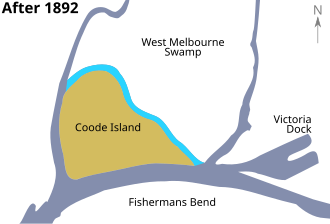Coode Island
| Coode Island Victoria | |
|---|---|
 Container docks along the eastern side of the island | |
| Coordinates | 37°48′53″S 144°54′35″E / 37.81472°S 144.90972°E |
| Elevation | 5 m (16 ft) |
| Area | 0.97 km2 (0.4 sq mi) |
| Region | West Melbourne |
Coode Island is a former island at the convergence of the Yarra and Maribyrnong Rivers, 4 km west of central Melbourne, Australia. The island was formed by the excavation of the Coode Canal in 1887, and became connected to the mainland in the 1930s.[1] Today the low-lying land is part of the Port of Melbourne, and is used as the site of Swanson and Appleton Docks and their associated container storage and rail yards, as well as a number of chemical storage facilities.

History
[edit]
Before the 1880s, the area of Coode Island was an expansive low-lying wetland. The island became isolated from the mainland after the Coode Canal was dug in 1886, to shorten, widen and deepen the Yarra River.[2][3] A shipping canal was constructed to the south of the existing course of the river through Fishermans Bend, to allow access from the Port of Melbourne to Yarraville. The boundaries were the canal on the south, the Maribyrnong River on the west, and the Yarra River on the north and east. Once formed, the island became an industrial area of 97 hectares.
The island was named after Sir John Coode, an English harbour engineer who had been engaged by the Melbourne Harbor Trust to select the optimum route for the canal as part of the Port of Melbourne. The original course of the Yarra River was gradually filled in over the years, along with the associated swamps. By the mid-twentieth century, Coode Island was no longer an island, although the name remained.
By 1909, the area was being used as an animal quarantine station and, after 1915, as a sanatorium for victims of bubonic plague and other contagious diseases.[4] By the 1920s, the area was inhabited by people living in huts and abandoned ships.[citation needed] In 1927, the Larkin Aircraft Supply Company had set up operations on the island, including a factory and aerodrome,[5][6] which was used until World War II.
In 1960, the area began to be used for the storage of petrochemicals. In 1968, the Swanson Dock container terminal was constructed on the south side of the former island, which reduced its size.
On 21 August 1991, a storage tank caught fire at the Anchor Tank facility on Coode Island, probably due to St. Elmo's fire, resulting in an explosion.[7][8] About 8.5 million litres of organic compounds burned, including acrylonitrile and benzene, creating a toxic cloud over nearby residential suburbs, which was dispersed by strong winds.[9][10][11][12] The ignition spread between tanks through a common vent system. Tank blanketing had been considered unnecessary when the tanks were designed, and the common vent system was later installed to allow recovery of fumes for environmental reasons.[13]
Proposals were made to move the facility to Point Lillias near Geelong,[14][15] but environmental and Aboriginal heritage concerns thwarted the plans. In 2000 the Bracks Government announced that Coode Island would be the site of Victoria's major petrochemical storage facility, with six companies leasing the facility from the Melbourne Port Authority.
See also
[edit]References
[edit]- ^ "Coode Island". Victorian Places. Monash University, University of Queensland. 2015. Retrieved 18 September 2019.
- ^ "History of the port". Port of Melbourne. Archived from the original on 7 September 2012. Retrieved 21 August 2008.
- ^ "Great Harbour Projected". The Argus: An Historic Souvenir. Melbourne. 9 September 1926 – via Trove.
- ^ "Coode Island". The Sydney Morning Herald. 3 July 1915 – via Trove.
It is proposed that returning soldiers suffering from contagious diseases, such as typhoid fever and measles, shall be accommodated at Coode Island
- ^ Smith, Ann G. (1983). "Larkin, Herbert Joseph (1894–1972)". Australian Dictionary of Biography. Canberra: National Centre of Biography, Australian National University. ISBN 978-0-522-84459-7. ISSN 1833-7538. OCLC 70677943. Retrieved 21 August 2008.
- ^ "Coode Island Air Port". The Argus. 14 September 1927. p. 23 – via Trove.
- ^ "Coode Island, Melbourne, Vic: Explosion & Chemical Fire". Emergency Management Australia. Archived from the original on 16 September 2008. Retrieved 21 August 2008.
- ^ "Industrial - Coode Island, Victoria | Australian Disaster Resilience Knowledge Hub".
- ^ "Chemical accidents at Coode Island". Hazardous Materials Action Group. 1991 Aug 21-22. Archived from the original on 19 April 2011.
Fire and explosion in tanks at Terminals, involving acrylonitrile (acts like cyanide on the human body), Benzene (effects nervous system and causes leukaemia), Phenol and Methyl Ethyl Ketone. Residents and workers evacuated from the immediate vicinity; other residents told to stay inside. Smoke plume carried as far as Fern Tree Gully and covered the Central Business District. A number of firefighters were injured.
- ^ Coode Island Community Consultative Committee (March 1992). "Coode Island Review Panel, FINAL REPORT". State Government of Victoria.
- ^ Gibson, Kathy; O'Donovan, Gary. "Don't Mention It - Coode Island and Environmental Disclosure Strategies in the Australian Chemicals Industry" (PDF). Edwards School of Business. Archived from the original (PDF) on 24 March 2012.
- ^ Clive Hale (1991). "Coode Island chemical fire". YouTube. ABC News. Archived from the original on 14 December 2021.
- ^ Trevor Kletz - Learning from Accidents
- ^ "About Coode Island". Coode Island Community Consultative Committee. July 2015. Retrieved 18 September 2019.
- ^ "The Point Lillias Chemical Storage Facility: A proposed chemical storage facility for Victoria". Chemlink. 2006.

